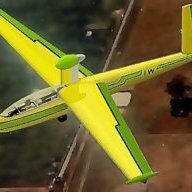No -that was a twin-engined aircraft in disguise. Westland Wyvern. (And Wright Flyer, if you think about it).
Adverse aileron effect always increases with increased wing span in proportion to fuselage length; that's why doing some early training on gliders is good for curing "lazy feet". To a degree, it's a price you have to pay for increased aerodynamic efficiency. However, I agree that quite a lot of aircraft seem to have their vertical tails designed by eye; and what we are accustomed to thinking of as "pretty" in this regard is based pretty much on WW2 fighters - almost all of which had vertical tails that were barely adequate; you only have to look at the development history of the Spitfire - its vertical tail almost doubled by the Mk 24. As my flying experience increased, I found myself increasingly irritated by aircraft with inadequate directional stability, so I know what you mean. There are quite a lot of aircraft I'd walk way from, too.
Also, most vertical tails are, even now, incorrectly designed for spin recovery. If the designers MUST imitate the F 86 swept tail, they could at least learn something from the evolved form of it on the F-18 - it has two of them, and each is large enough to be worth hiring as advertising space . . .
Another aspect of this problem is improper control harmonisation; and both the early Jabiru and the Skyfox suffered from this; the rudder forces were too light, so it had very little "feel". Quite a few gliders also have this defect; the H201 Libelle and the Ka2 were amongst the worst - but people get used to them and love them (I didn't). I've not sampled much of the current crop of recreational aeroplanes, they don't turn me on, so I can't comment on them; but the desirable control harmonisation is generally considered to be that the ailerons should be the most responsive control relative to the pilot effort; the elevator should be twice as "heavy" as the ailerons, and the rudder twice as "heavy" as the elevator. I've found many gliders and such recreational types as I've flown, the opposite way round - the rudder is lightest and the ailerons heaviest. This does not make them good training aircraft, I should imagine. Once you'e experienced an aircraft with correct harmonisation, the others become quite annoying to fly.
So I agree, Turbs, but that does not answer the question. Adding rudder trim is treating the symptoms, and it's something you can forget in pre-take-off checks and it can be a real nuisance in an aborted landing.





